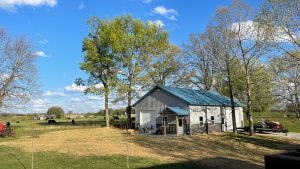More than once (especially in California), it has been suggested by lumber yards to use cedar or redwood posts for pole buildings, rather than pressure preservative treated wood of other species. The lumber yard sales people are of the belief the cedar or redwood posts should have adequate natural resistance to decay to last the lifetime of the building.
At home, one of my own pole buildings has a cedar deck on top of it (yes, on top, which is the topic for a future blog). About 15 years old, many of the redwood deck boards had to be replaced last summer, as they had decayed to the point of being unsafe.
In the 1994 Encyclopedia of Agricultural Science, Jerrold E. Winandy wrote, “It is commonly recognized that heartwood lumber from these well-known commercial species contains extractives that are toxic to a variety  of wood-decay fungi: “Heartwood forms as the living sapwood cells gradually die. In some species, the sugars present in the cells are converted to highly toxic extractives that are deposited in the wood cell wall. Many species produce durable heartwood, including western red cedar, redwood, and black locust; however, durability varies within a tree and between trees of a given species.”
of wood-decay fungi: “Heartwood forms as the living sapwood cells gradually die. In some species, the sugars present in the cells are converted to highly toxic extractives that are deposited in the wood cell wall. Many species produce durable heartwood, including western red cedar, redwood, and black locust; however, durability varies within a tree and between trees of a given species.”
In contrast, “sapwood of all species has little resistance to deterioration and fails rapidly in adverse environments.””
In 2005, Professor Paul Fisette of the University of Massachusetts Amherst wrote an article titled ‘Wood Myths: Facts and Fictions About Wood‘, which warned consumers against the myth all cedar and redwood are rot resistant: “Like fingernails on a blackboard, homeowners bubble, ‘I have cedar siding.’ Don’t get me wrong, cedar is my choice for siding too, but let’s get something straight. Not all siding, decking and trim made from cedar, redwood or other species famous for durability are in fact rot resistant. Only the heartwood of certain species is naturally decay resistant. Untreated sapwood of virtually all species has very little decay resistance. You can expect a short service life if you use sapwood in decay-producing exposures. Large old-growth trees are a thing of the past. We now harvest smaller second growth material that contains a high percentage of sapwood. Heartwood lumber is essentially unavailable in many species. Specify ‘all-heart’ and you may be in for a dose of sticker shock. But if durability is important to your design, you should make heartwood part of your budget.”
Professor Fisette was writing about cedar and redwood for use as siding, which is a strictly an above ground application. The use of cedar or redwood posts for structural in ground use appears to be nothing short of a recipe for disaster, or at the very least, dissatisfaction when the columns decay and must be replaced. And that, my friends, comes from the voices of experts when it comes to decay and rot in cedar or redwood posts.






